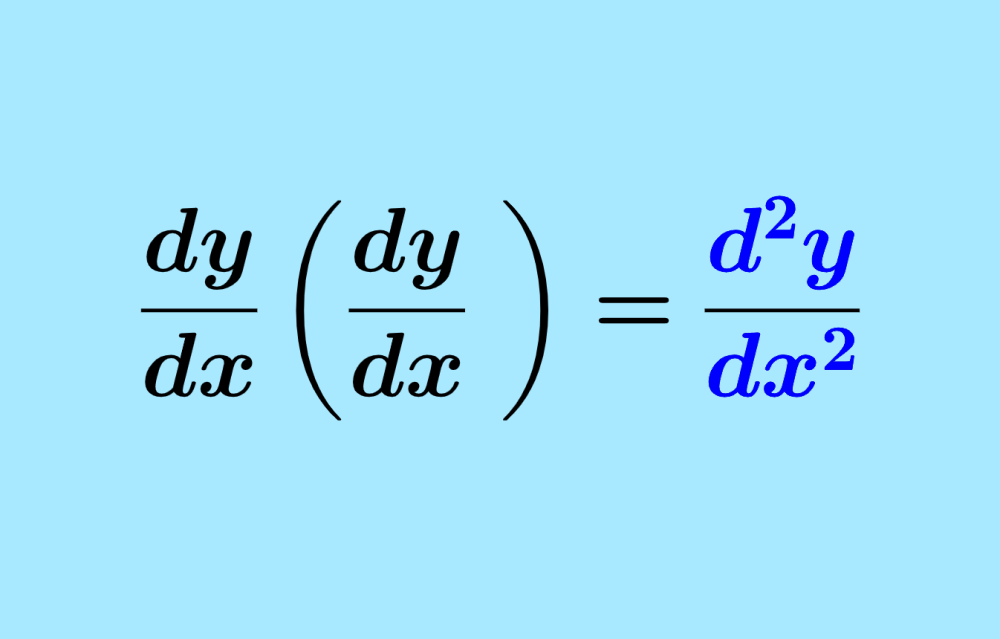The second derivative of a function is found by differentiating the first derivative of the function. This means that we can find the second derivative by differentiating a function twice. The rules used will depend on the type of function we have. For example, for polynomial functions, we use the power rule of derivatives.
Here, we will solve 10 examples of the second derivative of a function. In addition, we will explore 5 practice problems to test your knowledge of this topic.
How to find the second derivative of a function
To find the second derivative of a function, we have to differentiate the function twice. For example, suppose we want to find the second derivative of the following function:
$$f(x) = 2x+\frac{1}{x}$$
For this, we follow the following steps:
1. Write radicals or rational expressions in exponential form with the laws of exponents.
In this case, we have:
$latex f(x)= 2x+x^{-1}$
2. Find the first derivative of the function using the power rule or other applicable rules.
In this case, we use the power rule in both terms of the function:
$latex f(x)= 2x+x^{-1}$
$latex f'(x)= 2-x^{-2}$
3. Differentiate $latex f'(x)$ using any applicable rule.
In this case, we use the power rule again:
$latex f'(x)= 2-x^{-2}$
$latex f^{\prime \prime}(x)= 2x^{-3}$
4. Simplify the resulting expression.
In this case, we use the laws of exponents to write as follows:
$$f^{\prime \prime}(x)=\frac{2}{x^3}$$
10 Examples of the second derivative of a function with answers
EXAMPLE 1
Find the second derivative of $latex f(x)=5x^3$.
Solution
To find the second derivative, we have to start by finding the first derivative of the function. Thus, we differentiate the function using the power rule of derivatives:
$latex f(x)=5x^3$
$latex f'(x)=15x^2$
Now, we use the power rule again to differentiate $latex f'(x)$:
$latex f'(x)=15x^2$
$latex f^{\prime \prime}(x)=30x$
The second derivative is $latex f^{\prime \prime}(x)=30x$.
EXAMPLE 2
What is the second derivative of the function $latex f(x)=4x^4-2x^2+7x$?
Solution
We can use the power rule of derivatives on each term of the function to find the first derivative:
$latex f(x)=4x^4-2x^2+7x$
$latex f'(x)=16x^3-4x+7$
Now, let’s differentiate $latex f'(x)$ to find the second derivative using the same method:
$latex f'(x)=16x^3-4x+7$
$latex f^{\prime \prime}(x)=48x^2-4$
EXAMPLE 3
Find the second derivative of the function $latex f(x)=5x^6+\frac{3}{x}$.
Solution
We have a rational expression. Therefore, we can use the laws of exponents to write as follows:
$$f(x)=5x^6+\frac{3}{x}$$
$latex f(x)=5x^6+3x^{-1}$
Now that we only have numerical exponents, we use the power rule to differentiate:
$latex f(x)=5x^6+3x^{-1}$
$latex f'(x)=30x^5-3x^{-2}$
Differentiating $latex f'(x)$, we have:
$latex f'(x)=30x^5-3x^{-2}$
$latex f^{\prime \prime}(x)=150x^4+6x^{-3}$
Using the laws of exponents, we can write as follows:
$latex f^{\prime \prime}(x)=150x^4+6x^{-3}$
$$f^{\prime \prime}(x)=150x^4+\frac{6}{x^3}$$
EXAMPLE 4
What is the second derivative of $latex f(x) = -3x^{-5}+\sqrt{x}$?
Solution
We can write the square root as a numerical exponent:
$$f(x) = -3x^{-5}+\sqrt{x}$$
$$f(x)=-3x^{-5}+x^{\frac{1}{2}}$$
Now, we can find the first derivative as follows:
$$f(x)=-3x^{-5}+x^{\frac{1}{2}}$$
$$f'(x)=15x^{-6}+\frac{1}{2}x^{-\frac{1}{2}}$$
We find the second derivative by differentiating $latex f'(x)$:
$$f'(x)=15x^{-6}+\frac{1}{2}x^{-\frac{1}{2}}$$
$$f^{\prime \prime}(x)=-90x^{-7}-\frac{1}{4}x^{-\frac{3}{2}}$$
We can simplify by using the laws of exponents and writing as follows:
$$f^{\prime \prime}(x)=-90x^{-7}-\frac{1}{4}x^{-\frac{3}{2}}$$
$$f^{\prime \prime}(x)=-\frac{90}{x^7}-\frac{1}{4\sqrt{x^3}}$$
EXAMPLE 5
What is the second derivative of $latex f(x)=\sin(x)-\cos(x)$?
Solution
In this case, we have a trigonometric function. We can differentiate by recalling that the derivative of sine equals cosine and the derivative of cosine equals negative sine:
$latex f(x)=\sin(x)-\cos(x)$
$latex f'(x)=\cos(x)+\sin(x)$
We apply the same rules to derive again:
$latex f'(x)=\cos(x)+\sin(x)$
$latex f^{\prime \prime}(x)=-\sin(x)+\cos(x)$
EXAMPLE 6
Determine the second derivative of the function $latex f(x)=\frac{1}{\sqrt{x}}+3x^{-3}+5$.
Solution
We can start by simplifying as follows:
$$f(x)=\frac{1}{\sqrt{x}}+3x^{-3}+5$$
$latex f(x)=x^{-\frac{1}{2}}+3x^{-3}+5$
Now, we differentiate using the power rule on each term of the function:
$latex f(x)=x^{-\frac{1}{2}}+3x^{-3}+5$
$$f'(x)=-\frac{1}{2}x^{-\frac{3}{2}}-9x^{-4}$$
We differentiate $latex f'(x)$ to obtain the second derivative:
$$f'(x)=-\frac{1}{2}x^{-\frac{3}{2}}-9x^{-4}$$
$$ f”(x)=\frac{3}{4}x^{-\frac{5}{2}}+36x^{-5}$$
We use the laws of exponents again to simplify:
$$ f^{\prime \prime}(x)=\frac{3}{4}x^{-\frac{5}{2}}+36x^{-5}$$
$$ f^{\prime \prime}(x)=\frac{3}{4x^{\frac{5}{2}}}+\frac{36}{x^5}$$
$$ f^{\prime \prime}(x)=\frac{3}{4\sqrt{x^5}}+\frac{36}{x^5}$$
EXAMPLE 7
Find the second derivative of $latex f(x)=\frac{2}{3x^2}-\frac{4}{x^5}$.
Solution
We use the laws of exponents to write like this:
$$f(x)=\frac{2}{3x^2}-\frac{4}{x^5}$$
$$ f(x)=\frac{2}{3}x^{-2}-4x^{-5}$$
Using the power rule on both terms of the function, we have:
$$f(x)=\frac{2}{3}x^{-2}-4x^{-5}$$
$$f'(x)=-\frac{4}{3}x^{-3}+20x^{-6}$$
Differentiating $latex f'(x)$, we have:
$$f'(x)=-\frac{4}{3}x^{-3}+20x^{-6}$$
$$f^{\prime \prime}(x)=4x^{-4}-120x^{-7}$$
Finally, we can write as follows:
$$f^{\prime \prime}(x)= \frac{4}{x^4}-\frac{120}{x^7}$$
EXAMPLE 8
If we have $latex f(x)=4x^3$, find $latex f'(x)$ and $latex f^{\prime \prime}(x)$. Then prove that $latex 3f(x)f^{\prime \prime}(x)-2f'(x)^2=0$.
Solution
To solve this problem, we have to start by finding the first and second derivatives of the function. Thus, we have:
$latex f(x)=4x^3$
$latex f'(x)=12x^2$
$latex f^{\prime \prime}(x)=24x$
Now, we can substitute into the left-hand side of $latex 3f(x)f^{\prime \prime}(x)-2f'(x)^2=0$, and we have:
$latex 3f(x)f^{\prime \prime}(x)-2f'(x)^2=0$
$$3(4x^3)(24x)-2(12x^2)^2=0$$
$latex 288x^4-288x^4=0$
We see that the left side is equal to 0, so we have proved what is required.
EXAMPLE 9
If we have $latex f(x)=\frac{1}{\sqrt{x}}$, prove that $latex 2xf^{\prime \prime}(x)+3f'(x)=0$
Solution
Similar to the previous example, we need to start by finding the first and second derivatives of the function. Thus, we have:
$$f(x)=\frac{1}{\sqrt{x}}=x^{-\frac{1}{2}}$$
$$f'(x)=-\frac{1}{2}x^{-\frac{3}{2}}$$
$$f^{\prime \prime}(x)=\frac{3}{4}x^{-\frac{5}{2}}$$
Now that we have the derivatives, let’s substitute in the left-hand side of $latex 2xf^{\prime \prime}(x)+3f'(x)=0$, and we have:
$latex 2xf^{\prime \prime}(x)+3f'(x)=0$
$$2x(\frac{3}{4}x^{-\frac{5}{2}})+3(-\frac{1}{2}x^{-\frac{3}{2}})=0$$
$$\frac{3}{2}x^{-\frac{3}{2}}-\frac{3}{2}x^{-\frac{3}{2}}=0$$
The left-hand side is equal to 0, so we have proved that the given expression is true.
EXAMPLE 10
If we have $latex f(x)=x^4$, prove that $latex \frac{4y}{3}f^{\prime \prime}(x)-(f'(x))^2= 0$.
Solution
The derivatives of the given function are as follows:
$latex f(x)=x^4$
$latex f'(x)=4x^3$
$latex f^{\prime \prime}(x)=12x^2$
Now, we can substitute into the left-hand side of $latex \frac{4y}{3}f^{\prime \prime}(x)-(f'(x))^2=0$, and we have:
$$\frac{4y}{3}f^{\prime \prime}(x)-(f'(x))^2=0$$
$$\frac{4(x^4)}{3}(12x^2)-(4x^3)^2=0$$
$latex 16x^6-16x^6=0$
We see that the left-hand side is equal to 0, so we have proved that the given expression is true.
Second derivative of a function – Practice problems


Find the value of $latex f^{\prime \prime}(4)$ if we have the following function: $$f(x)=x^2-32\sqrt{x}$$
Write the answer in the input box.
See also
Interested in learning more about derivatives? You can take a look at these pages:




